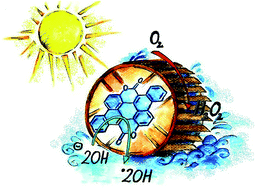当前位置:
X-MOL 学术
›
J. Mater. Chem. A
›
论文详情
Our official English website, www.x-mol.net, welcomes your feedback! (Note: you will need to create a separate account there.)
Biscoumarin-containing acenes as stable organic semiconductors for photocatalytic oxygen reduction to hydrogen peroxide
Journal of Materials Chemistry A ( IF 11.9 ) Pub Date : 2017-09-25 00:00:00 , DOI: 10.1039/c7ta05882a Marek K. Węcławski 1, 2, 3, 4 , Marie Jakešová 5, 6, 7, 8, 9 , Martyna Charyton 1, 2, 3, 4 , Nicola Demitri 10, 11, 12 , Beata Koszarna 1, 2, 3, 4 , Kerstin Oppelt 7, 8, 9, 13 , Serdar Sariciftci 5, 6, 7, 8, 9 , Daniel T. Gryko 1, 2, 3, 4 , Eric Daniel Głowacki 14, 15, 16, 17, 18
Journal of Materials Chemistry A ( IF 11.9 ) Pub Date : 2017-09-25 00:00:00 , DOI: 10.1039/c7ta05882a Marek K. Węcławski 1, 2, 3, 4 , Marie Jakešová 5, 6, 7, 8, 9 , Martyna Charyton 1, 2, 3, 4 , Nicola Demitri 10, 11, 12 , Beata Koszarna 1, 2, 3, 4 , Kerstin Oppelt 7, 8, 9, 13 , Serdar Sariciftci 5, 6, 7, 8, 9 , Daniel T. Gryko 1, 2, 3, 4 , Eric Daniel Głowacki 14, 15, 16, 17, 18
Affiliation

|
Conversion of solar energy into chemical energy in the form of hydrogen peroxide and other reactive oxygen species has been predicted to be an efficient strategy, yet few organic materials systems support these types of photochemical conversion reactions. Herein we report a simple synthetic route to yield biscoumarin-containing acenes, semiconducting small molecules with exceptional stability and tunable electrochemical and electrical properties. We find that these semiconductors are photo(electro)catalysts capable of reducing oxygen to hydrogen peroxide. Visible light irradiation of thin films on insulating substrates in pure water results in H2O2 photogeneration with water as the sacrificial electron donor. Thin films on conducting substrates are robust catalytic photocathodes for producing H2O2. These semiconductor photoelectrodes retain their catalytic properties in a pH range from 2–13. Photocatalytic or photoelectrocatalytic deployment of biscoumarin-containing acenes does not lead to measurable degradation. This work demonstrates a strategy to synthesize stable organic semiconductors not only suitable for thin-film electronic devices but also next-generation photocatalytic concepts.
中文翻译:

含双香豆素的并苯作为稳定的有机半导体,用于将光催化氧还原为过氧化氢
已经预言将太阳能以过氧化氢和其他活性氧的形式转化为化学能是一种有效的策略,但是很少有有机材料系统支持这些类型的光化学转化反应。在本文中,我们报告了一种简单的合成路线,以生产含双香豆素的并苯,具有优异的稳定性和可调的电化学和电学性质的半导体小分子。我们发现这些半导体是能够将氧还原为过氧化氢的光(电)催化剂。在纯水中对绝缘基板上的薄膜进行可见光照射会产生H 2 O 2以水为牺牲电子供体进行光生。导电基板上的薄膜是用于产生H 2 O 2的坚固的催化光阴极。这些半导体光电极在2-13的pH范围内保持其催化性能。含双香豆素的并苯的光催化或光电催化部署不会导致可测量的降解。这项工作展示了一种合成稳定的有机半导体的策略,该策略不仅适用于薄膜电子设备,而且适用于下一代光催化概念。
更新日期:2017-09-26
中文翻译:

含双香豆素的并苯作为稳定的有机半导体,用于将光催化氧还原为过氧化氢
已经预言将太阳能以过氧化氢和其他活性氧的形式转化为化学能是一种有效的策略,但是很少有有机材料系统支持这些类型的光化学转化反应。在本文中,我们报告了一种简单的合成路线,以生产含双香豆素的并苯,具有优异的稳定性和可调的电化学和电学性质的半导体小分子。我们发现这些半导体是能够将氧还原为过氧化氢的光(电)催化剂。在纯水中对绝缘基板上的薄膜进行可见光照射会产生H 2 O 2以水为牺牲电子供体进行光生。导电基板上的薄膜是用于产生H 2 O 2的坚固的催化光阴极。这些半导体光电极在2-13的pH范围内保持其催化性能。含双香豆素的并苯的光催化或光电催化部署不会导致可测量的降解。这项工作展示了一种合成稳定的有机半导体的策略,该策略不仅适用于薄膜电子设备,而且适用于下一代光催化概念。



























 京公网安备 11010802027423号
京公网安备 11010802027423号